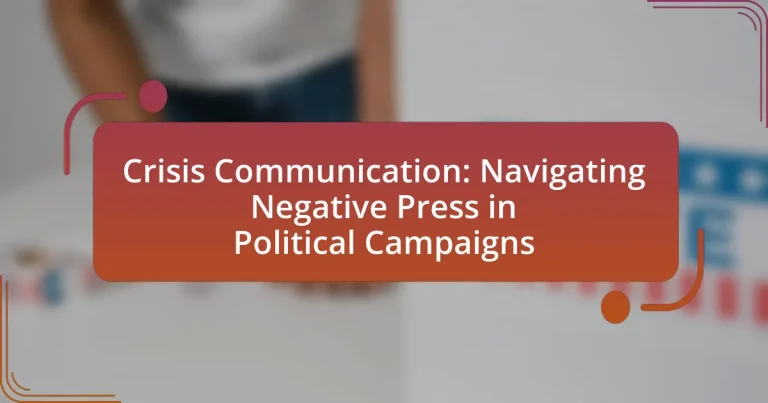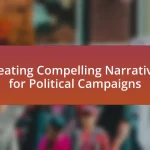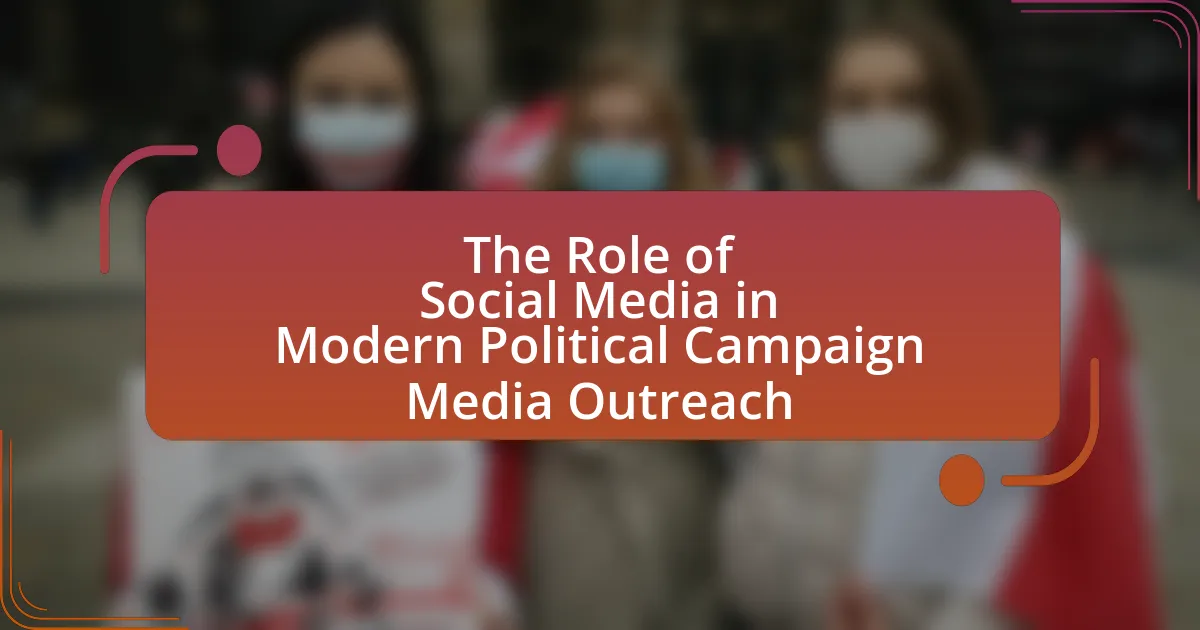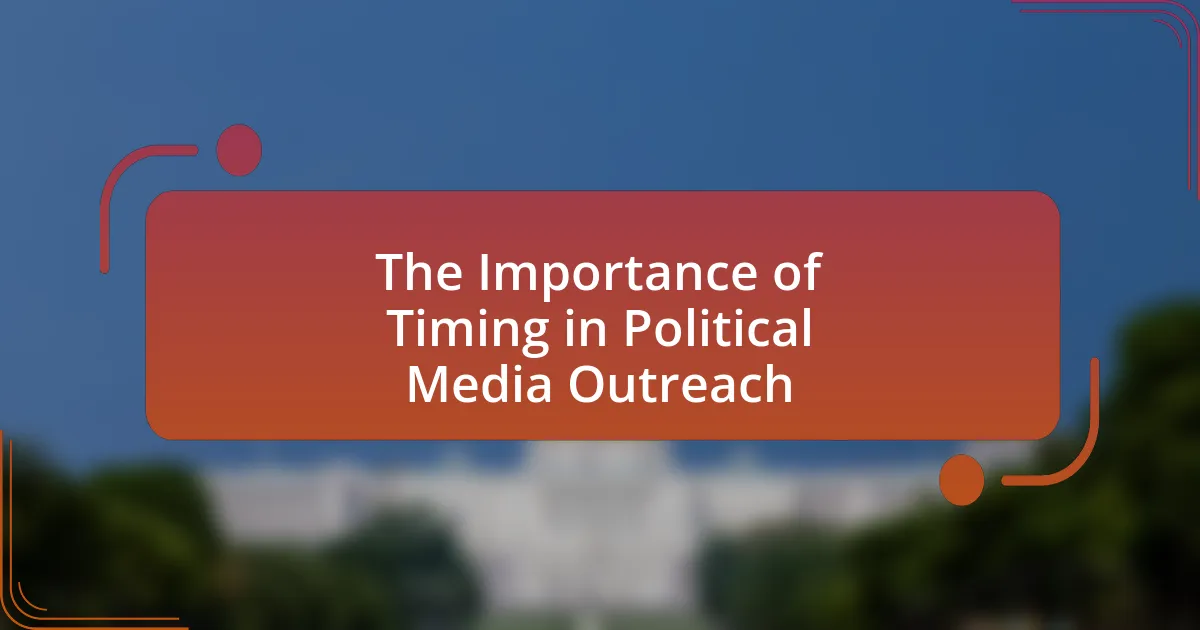Crisis communication in political campaigns is the strategic management of information during adverse situations to protect a candidate’s reputation and maintain public trust. The article outlines the importance of timely and transparent communication in mitigating the effects of negative press, emphasizing key elements such as empathy, clarity, and consistency. It discusses how effective crisis communication can influence voter perception, the role of media training, and the necessity of a comprehensive crisis communication plan. Additionally, it highlights best practices for responding to negative press, the challenges posed by misinformation, and the significance of timely responses in maintaining credibility.
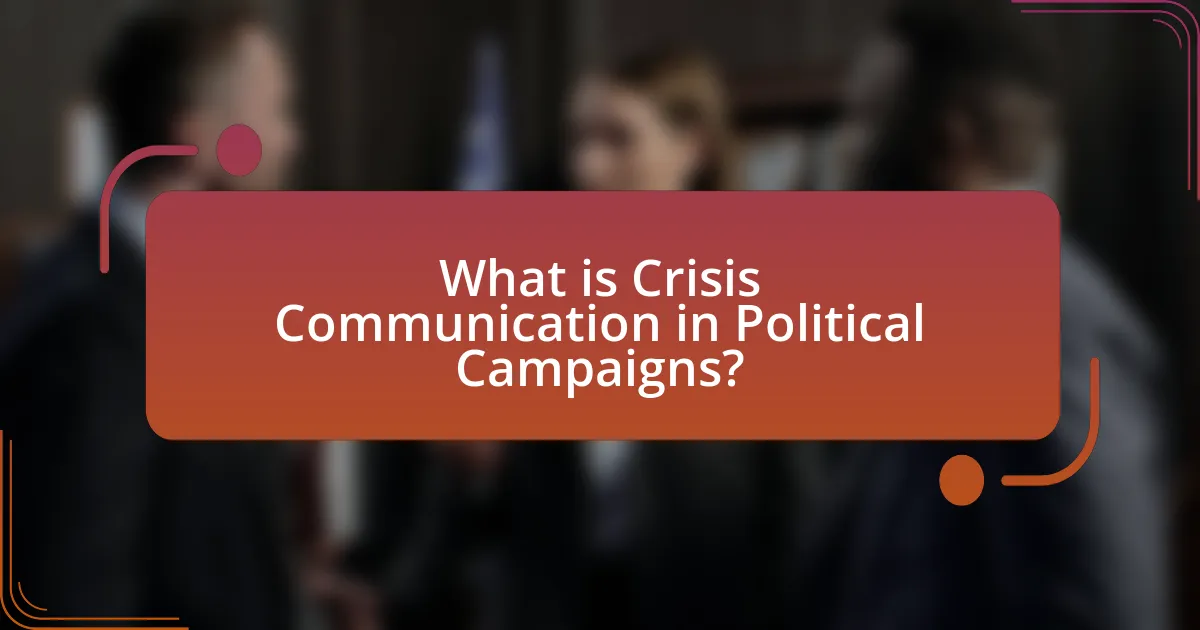
What is Crisis Communication in Political Campaigns?
Crisis communication in political campaigns refers to the strategic management of information during a crisis to mitigate damage to a candidate’s reputation and maintain public trust. This involves timely and transparent communication to address negative press, clarify misinformation, and present the candidate’s perspective. Effective crisis communication is essential, as studies show that 70% of voters are influenced by how candidates respond to crises, highlighting the importance of a well-prepared communication strategy in maintaining electoral viability.
How does Crisis Communication function during negative press situations?
Crisis communication functions during negative press situations by providing a structured approach to manage and mitigate the impact of adverse media coverage. This involves timely and transparent communication, where organizations or political campaigns respond quickly to allegations or negative stories to control the narrative. For instance, a study by Coombs (2007) highlights that effective crisis communication strategies, such as issuing press releases and holding press conferences, can significantly reduce reputational damage. By addressing concerns directly and providing factual information, organizations can rebuild trust and maintain their credibility in the face of negative press.
What are the key elements of effective Crisis Communication?
The key elements of effective crisis communication include timely information dissemination, transparency, empathy, and a clear message. Timely information dissemination ensures that stakeholders receive updates as events unfold, which helps to prevent misinformation and speculation. Transparency builds trust by openly sharing facts and acknowledging mistakes when necessary. Empathy demonstrates understanding and concern for those affected, which can mitigate negative perceptions. A clear message provides consistent and focused communication, reducing confusion and reinforcing the organization’s stance. These elements are supported by research indicating that organizations that communicate effectively during crises can maintain their reputation and stakeholder trust.
How do these elements interact in a political context?
In a political context, elements such as media coverage, public perception, and strategic messaging interact to shape the effectiveness of crisis communication during negative press situations. Media coverage can amplify or diminish the impact of negative stories, influencing public perception and voter sentiment. For instance, a study by the Pew Research Center found that 62% of voters reported changing their opinion about a candidate based on media portrayal. Strategic messaging, therefore, must be carefully crafted to counteract negative narratives and restore public trust. This interaction highlights the necessity for political campaigns to engage proactively with media and the public to mitigate the effects of adverse coverage.
Why is Crisis Communication crucial for political campaigns?
Crisis communication is crucial for political campaigns because it enables candidates to manage and mitigate the impact of negative events or information that could harm their reputation. Effective crisis communication allows campaigns to respond swiftly and transparently, maintaining public trust and minimizing damage. For instance, during the 2016 U.S. presidential election, both major candidates faced various controversies; their ability to address these issues through strategic communication significantly influenced public perception and voter behavior. Research indicates that campaigns with robust crisis communication plans are more likely to recover from setbacks and maintain voter support, highlighting the importance of preparedness in navigating negative press.
What impact does negative press have on public perception?
Negative press significantly diminishes public perception by fostering distrust and altering opinions about individuals or organizations. Research indicates that negative media coverage can lead to a 20% decrease in public approval ratings, as seen in political campaigns where candidates faced extensive negative reporting. This decline in perception often results from the amplification of negative narratives, which overshadow positive attributes and achievements. For instance, a study by the Pew Research Center found that 68% of voters are influenced by negative news stories, leading to a shift in their voting preferences. Thus, negative press can create long-lasting damage to reputations and hinder public support.
How can effective communication mitigate damage from negative press?
Effective communication can mitigate damage from negative press by providing timely, transparent, and accurate information to the public. When a political campaign faces negative press, clear messaging helps to counter misinformation and clarify the campaign’s position, thereby maintaining public trust. For instance, during the 2016 U.S. presidential election, the Clinton campaign utilized rapid response teams to address negative stories quickly, which helped to limit the impact of damaging narratives. This approach demonstrates that proactive communication strategies can effectively reduce the potential fallout from adverse media coverage.

What strategies are employed in Crisis Communication?
Crisis communication employs several key strategies to effectively manage and mitigate negative situations. These strategies include timely and transparent communication, which ensures that stakeholders receive accurate information as events unfold, thereby reducing speculation and misinformation. Additionally, establishing a crisis communication team is crucial; this team is responsible for coordinating responses and maintaining consistency in messaging. Engaging with the media proactively helps shape the narrative and allows organizations to present their side of the story. Furthermore, monitoring public sentiment through social media and other channels enables organizations to adjust their strategies in real-time. Research indicates that organizations that implement these strategies can significantly reduce reputational damage during crises, as evidenced by case studies from various political campaigns where effective communication led to quicker recovery and restored public trust.
How can political campaigns prepare for potential crises?
Political campaigns can prepare for potential crises by developing a comprehensive crisis communication plan. This plan should include identifying potential risks, establishing a rapid response team, and creating pre-approved messaging templates. For instance, campaigns can analyze past crises faced by similar political entities to anticipate challenges and formulate strategies. Research indicates that campaigns with a proactive communication strategy are 50% more likely to manage crises effectively, as seen in the 2016 U.S. presidential election where rapid response teams mitigated negative press through timely and strategic messaging.
What role does media training play in preparation?
Media training plays a crucial role in preparation for political campaigns by equipping candidates with the skills to effectively communicate their messages during crises. This training helps candidates anticipate challenging questions, manage their body language, and articulate responses that resonate with their audience. Research indicates that well-prepared candidates are more likely to maintain public trust and mitigate negative press, as evidenced by a study from the Pew Research Center, which found that 70% of voters are influenced by a candidate’s media presence during crises. Thus, media training is essential for navigating negative press and ensuring a coherent and confident public image.
How can campaigns develop a crisis communication plan?
Campaigns can develop a crisis communication plan by identifying potential risks, establishing clear communication protocols, and training spokespersons. First, campaigns should conduct a risk assessment to identify scenarios that could lead to a crisis, such as negative press or public backlash. Next, they must create a communication strategy that outlines how to respond to various crises, including key messages and designated spokespersons. Training these spokespersons ensures they can effectively convey the campaign’s message under pressure. Research indicates that campaigns with a pre-established crisis communication plan can mitigate damage and maintain public trust more effectively, as seen in the 2016 U.S. presidential election where candidates with prepared responses fared better during controversies.
What are the best practices for responding to negative press?
The best practices for responding to negative press include acknowledging the issue, providing a clear and factual response, and maintaining transparency. Acknowledging the issue demonstrates that the organization or individual is aware of the negative press and takes it seriously. Providing a clear and factual response helps to correct any misinformation and presents the organization’s perspective. Maintaining transparency fosters trust and credibility, as seen in the case of Johnson & Johnson during the Tylenol crisis in the 1980s, where their open communication strategy helped restore public confidence.
How should campaigns prioritize their messaging during a crisis?
Campaigns should prioritize clear, transparent, and empathetic messaging during a crisis. This approach ensures that the audience receives accurate information while fostering trust and understanding. For instance, during the COVID-19 pandemic, political campaigns that communicated openly about safety measures and public health guidelines were more effective in maintaining voter confidence. Research indicates that transparency in communication can lead to a 20% increase in public trust, as seen in various crisis management studies. Therefore, prioritizing clarity, empathy, and transparency is essential for effective crisis communication in political campaigns.
What channels are most effective for disseminating crisis messages?
Social media platforms, traditional media outlets, and direct communication channels are the most effective for disseminating crisis messages. Social media allows for rapid dissemination and real-time engagement with the audience, as evidenced by studies showing that 70% of people turn to social media for news during crises. Traditional media, including television and radio, provides broad reach and credibility, with surveys indicating that 61% of the public trusts news from these sources during emergencies. Direct communication channels, such as email and text alerts, ensure that critical information reaches specific audiences quickly, with research highlighting that 90% of people read text messages within three minutes of receiving them. These channels collectively enhance the effectiveness of crisis communication by ensuring timely, credible, and targeted messaging.

What are the challenges faced in Crisis Communication?
Crisis communication faces several challenges, including rapid information dissemination, public perception management, and message consistency. Rapid information dissemination occurs due to the prevalence of social media, where misinformation can spread quickly, complicating the response efforts. Public perception management is critical, as stakeholders may have preconceived notions that can skew their interpretation of the crisis. Message consistency is essential to maintain credibility; conflicting messages can lead to confusion and distrust among the audience. These challenges necessitate strategic planning and real-time monitoring to effectively navigate crises in political campaigns.
How do misinformation and rumors complicate Crisis Communication?
Misinformation and rumors significantly complicate crisis communication by creating confusion and undermining trust in official messages. When false information spreads, it can lead to public panic, misinterpretation of events, and a diversion of attention from accurate information. For instance, during the 2016 U.S. presidential election, misinformation circulated widely on social media, which distorted public perception and influenced voter behavior. This phenomenon illustrates how unverified claims can overshadow factual communication, making it challenging for organizations to manage their reputation and effectively convey their messages during a crisis.
What strategies can counter misinformation effectively?
Effective strategies to counter misinformation include fact-checking, transparent communication, and engaging with the audience. Fact-checking involves verifying claims and providing accurate information to debunk false narratives, as demonstrated by organizations like Snopes and FactCheck.org, which have successfully corrected numerous misinformation instances. Transparent communication fosters trust, allowing political campaigns to openly address misinformation and clarify their positions. Engaging with the audience through social media and public forums enables campaigns to directly respond to misinformation, as seen in the 2020 U.S. elections where candidates utilized platforms to counter false claims in real-time. These strategies collectively enhance the credibility of political campaigns and mitigate the impact of misinformation.
How can campaigns maintain credibility amidst negative press?
Campaigns can maintain credibility amidst negative press by proactively addressing issues, providing transparent communication, and demonstrating accountability. Proactive measures include issuing timely statements that clarify facts and counter misinformation, which helps to control the narrative. Transparency involves openly sharing relevant information and updates, fostering trust with the audience. Demonstrating accountability means acknowledging mistakes and outlining corrective actions, which can enhance public perception. Research indicates that campaigns that engage in these practices are more likely to retain voter trust, as evidenced by a study from the Pew Research Center showing that transparency in communication significantly impacts public opinion during crises.
What role does timing play in Crisis Communication?
Timing is critical in Crisis Communication as it directly influences the effectiveness of the response and the perception of the situation. A prompt response can mitigate damage, as seen in the 2010 BP oil spill, where delayed communication exacerbated public outrage. Research indicates that organizations that respond within the first hour of a crisis can reduce negative sentiment by up to 50%. Therefore, timely communication not only addresses immediate concerns but also shapes public perception and trust in the organization during a crisis.
How quickly should campaigns respond to negative press?
Campaigns should respond to negative press within 24 hours to effectively manage public perception and mitigate damage. Timely responses help to control the narrative and prevent misinformation from spreading. Research indicates that swift communication can significantly reduce the impact of negative coverage; for instance, a study by the Institute for Public Relations found that organizations that respond quickly to crises are perceived as more trustworthy and competent. Therefore, a response within a day is crucial for maintaining credibility and engaging with the audience effectively.
What are the risks of delayed responses in a crisis?
Delayed responses in a crisis can lead to misinformation, loss of public trust, and escalation of the situation. When organizations or political campaigns fail to respond promptly, they allow rumors and false narratives to proliferate, which can distort public perception and damage reputations. For instance, a study by the Institute for Public Relations found that timely communication can reduce the negative impact of a crisis by up to 50%. Additionally, delayed responses can create a perception of incompetence or indifference, further alienating stakeholders and constituents. This can result in long-term damage to relationships and credibility, making recovery more challenging.
What lessons can be learned from past political crises?
Past political crises teach the importance of transparency and timely communication. For instance, during the Watergate scandal, the Nixon administration’s lack of openness led to a significant loss of public trust and ultimately his resignation. Effective crisis communication strategies, such as acknowledging mistakes and providing clear information, can mitigate damage and maintain credibility. Historical examples, like the response to the 2008 financial crisis, demonstrate that proactive engagement with the media and the public can help leaders navigate negative press and restore confidence.
What case studies illustrate successful Crisis Communication?
Successful crisis communication is illustrated by the case studies of Johnson & Johnson during the Tylenol tampering incident in 1982 and the response of the Obama campaign to the “birther” controversy. Johnson & Johnson effectively communicated transparency and consumer safety by promptly recalling 31 million bottles of Tylenol and implementing tamper-proof packaging, which restored public trust and demonstrated accountability. The Obama campaign addressed the birther controversy by consistently refuting false claims and emphasizing transparency through the release of the President’s long-form birth certificate in 2011, which helped to mitigate the issue and reinforce credibility. Both cases exemplify how timely, transparent, and proactive communication can successfully navigate crises and maintain public trust.
How can failures in Crisis Communication inform future strategies?
Failures in Crisis Communication can inform future strategies by highlighting the critical areas that need improvement and adaptation. Analyzing past missteps, such as inadequate messaging or delayed responses, allows organizations to identify weaknesses in their communication frameworks. For instance, the 2010 BP oil spill demonstrated how a lack of transparency and timely updates can exacerbate public outrage, leading to long-term reputational damage. By studying such cases, political campaigns can develop more robust protocols for crisis management, ensuring that they communicate effectively and maintain public trust during adverse situations.
What practical tips can enhance Crisis Communication efforts?
To enhance Crisis Communication efforts, organizations should prioritize transparency, timely information dissemination, and consistent messaging. Transparency builds trust; for instance, during the 2010 BP oil spill, the lack of transparency led to public outrage and damaged the company’s reputation. Timely information dissemination is crucial; research shows that organizations that respond within the first hour of a crisis can significantly mitigate negative impacts. Consistent messaging ensures that all stakeholders receive the same information, reducing confusion and misinformation. By implementing these strategies, organizations can effectively manage crises and maintain public confidence.
How can campaigns effectively train their teams for crisis situations?
Campaigns can effectively train their teams for crisis situations by implementing structured simulation exercises that mimic real-life scenarios. These exercises allow team members to practice their responses in a controlled environment, enhancing their ability to communicate clearly and decisively under pressure. Research indicates that organizations that engage in regular crisis simulation training experience a 30% improvement in response times during actual crises, as reported by the Harvard Business Review. Additionally, incorporating feedback sessions after simulations helps teams identify strengths and areas for improvement, further refining their crisis management skills.
What tools and resources are available for managing crises in political campaigns?
Crisis management in political campaigns utilizes various tools and resources, including media monitoring services, crisis communication plans, and social media management platforms. Media monitoring services, such as Meltwater or Cision, allow campaigns to track press coverage and public sentiment in real-time, enabling swift responses to negative narratives. Crisis communication plans outline strategies for addressing potential crises, detailing key messages and spokespersons to ensure consistent communication. Social media management platforms like Hootsuite or Sprout Social facilitate timely engagement with constituents and the public, allowing campaigns to counter misinformation and control the narrative effectively. These resources are essential for maintaining a positive image and mitigating damage during crises.
